The AHD-CV7 is a multi-purpose BNC to HDMI converter, supporting AHD/TVI/CVI to VGA, AHD to HDMI, and AHD to CVBS (analog CCTV) video conversion. The AHD-CV7 takes BNC video input from an AHD CCTV camera (720p , 1080p, 3mp and 5mp resolutions supported) and outputs the video resolution to the HDMI video output port. The AHD-CV7 is also an AHD to VGA converter because it also has a VGA video output. Last, this converter box can also be used as an AHD to CVBS converter using it's BNC video output.
Multiple AHD-CV7s can be used as a
video splitter to connect an AHD camera to multiple HDMI monitors. This is done using the AHD loop output (via BNC). The loop video output allows you to send the native AHD video signal to another device, such as a surveillance DVR.
This converter is typically used to connect an AHD security camera to an HDMI monitor to display a live high definition video feed. Click here to
see how this device can be used to display live surveillance video at a retail store entrance. The previous model did not include an AHD loop output, so it was commonly used with an AHD-VD104 to split AHD video signals and enable connection to both a DVR and monitor. This is no longer necessary with the latest model.
If you are looking for a solution to display video from multiple AHD cameras on a single monitor, please check out our
AHD video multiplexer. You may also be interested in our complete TV display systems for security cameras.
Watch this video to see how the AHD-CV7 works. In the video, we test 720p and 1080p AHD CCTV cameras.
AHD CCTV Video Converter Spec
- 1 BNC Video Input (AHD/TVI/CVI)
- 1 BNC Loop Output (AHD/TVI/CVI)
- 1 Analog CCTV BNC Output (CVBS)
- 1 HDMI Video Output
- 1 VGA Video Output
- Supported AHD/TVI/CVI Resolution: 720p 25/30, 1080p 25/30 3mp and 5mp
- Supported HDMI Resolution: 480, 576, 720p, 1080i, 1080p 25/30/50/60
- NTSC and Pal Formats Supported
- Video Signal Range: 0.8V p-p
- Power Consumption: 4 to 5 watts
- Operating Temperature: -10°C~60°C / -14°F~140°F
- Dimensions: 128mm x 84mm x 26mm
- 12V DC Power Supply Included
BNC Video Input, AHD Loop Out, HDMI Output
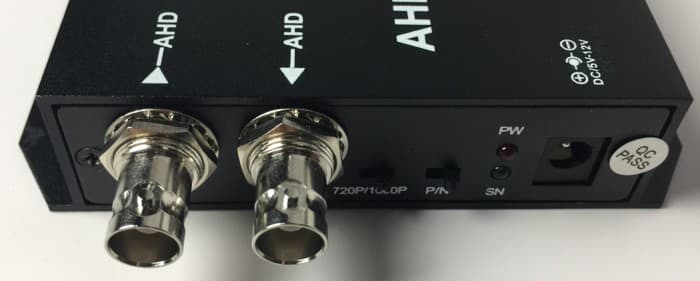
One AHD CCTV camera can be connected to the AHD-CV7 using the BNC video input. RG59 coax cable is typically used to run the video. The AHD-CV7 is compatible with PAL and NTSC video formats which are automatically detected. The AHD loop output acts as a video splitter and enabled one camera to be used with an HDMI monitor and another device that accepts AHD video input via BNC / coax cable, such as a DVR. The resolution can be toggled between 720P and 1080P depending on the type of AHD camera being used. The P/N switch allows the user to change from NTSC to PAL and vice versa. The LED light labeled "PW" indicates if the device is powered on / off. The "SN" LED let users know if the device is functioning properly. Flashing is a normal status. Off is not normal.
AHD to HDMI Converter Side View
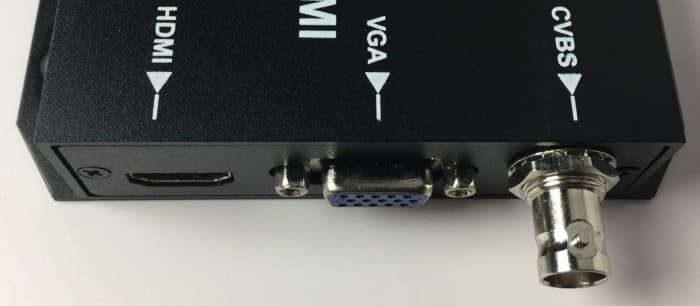
The HDMI / VGA out can be connected directly to an HDMI / VGA monitor / TV using an HDMI / VGA cable. Users also have the option of outputting a non-HD, CVBS signal that can be connected to a compatible BNC monitor, test monitor, or DVR.
How to Connect AHD Camera to HDMI Monitor
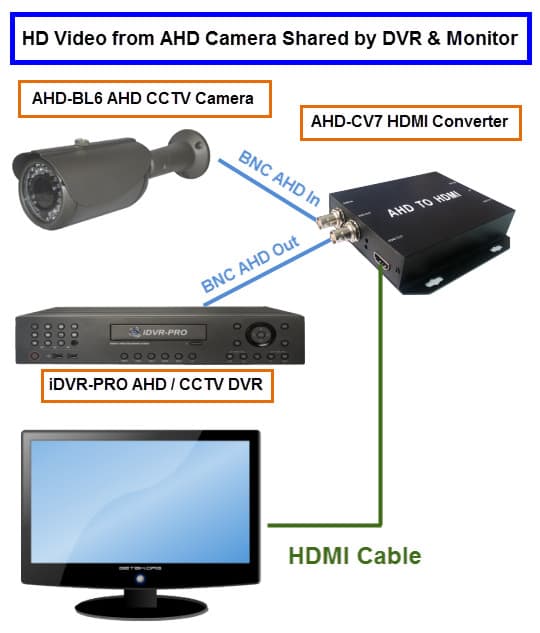
The above wiring diagram shows how to connect an AHD CCTV camera to an HDMI monitor and surveillance DVR. Because many AHD DVRs do not have loop outputs (like traditional CCTV DVRs do), the BNC AHD loop output is used to share the video signal between 2 devices. In this diagram, we share video from a single AHD security camera with an HD TV and a
hybrid CCTV / HD surveillance DVR. You may be interested in this article: How-to connect a BNC security camera to an HDMI TV.
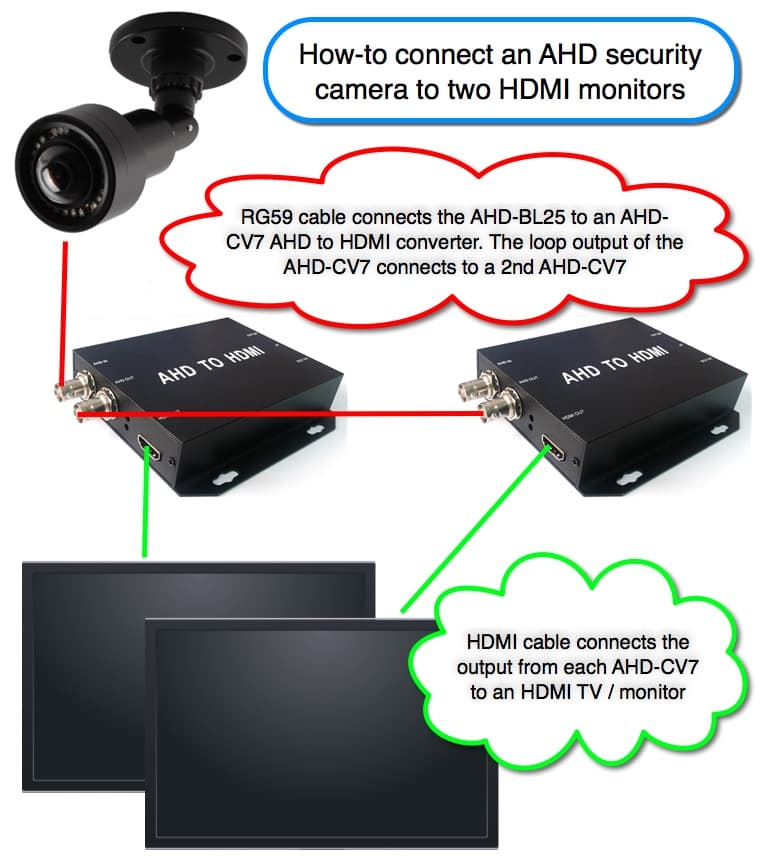
The above diagram shows an A
HD-BL25 180 camera connected to two HD TVs using two AHD-CV7s that are linked together using an RG59 jumper cable. Here is how it works.
- The AHD-BL25 is connected to an AHD-CV7 AHD to HDMI video converter using RG59 coax cable. You can use this premade Siamese cables for HD security cameras if you want to power the camera from a source near the first converter. Or if you are powering the camera at the location where the camera is installed, you can use these RG59 jumper cables.
- The AHD-CV7 has a BNC loop output which lets you connect the video to a second device using a coax jumper cable. In this installation, we connect it to a second AHD-CV7 using a pre-made RG59 jumper / patch cable. A 3rd AHD-CV7 could be connected to the 2nd one this same way if an additional monitor was needed. You can connect as many monitors as you need by adding additional AHD-CV7s.
- Last, use an HDMI cable to connect the HDMI output of each AHD-CV7 to a TV / monitor.
Watch this video to see how the AHD-CV7 works. The video also contains actual footage from a 720p and 1080p AHD camera being converted for use by an HDMI TV. This is the
dome AHD camera that we used in the video.
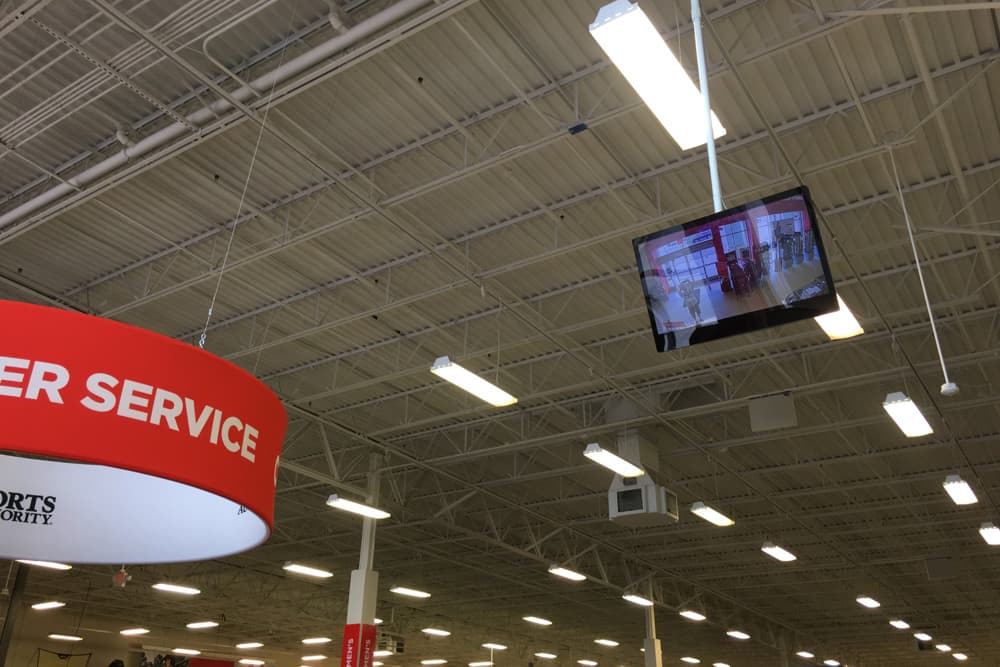
The AHD-CV7 can be used by retail stores to display a live surveillance video feed at the store entrance. This type of installation is very typically used by major retail chains. It creates a theft deterrence and helps customers feel safe knowing that the store uses security cameras.
AHD CCTV Cameras

You can
find AHD cameras here that are compatible with the AHD-CV7 video converter.
Related Articles










 Great to work with!
Great to work with! 




